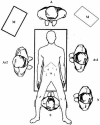The Laparoscopic Cholecystectomy and Common Bile Duct Exploration: A Single-Step Treatment of Pediatric Cholelithiasis and Choledocholithiasis
- PMID: 36291520
- PMCID: PMC9601212
- DOI: 10.3390/children9101583
The Laparoscopic Cholecystectomy and Common Bile Duct Exploration: A Single-Step Treatment of Pediatric Cholelithiasis and Choledocholithiasis
Abstract
Background: In recent years, complicated biliary tract diseases are increasingly diagnosed in children. Laparoscopic exploration of the common bile duct (LCBDE) followed by laparoscopic cholecystectomy has gained popularity in children. The aim of this study was to investigate the outcomes of LCBDE in children and compare them with the treatment outcomes of previously used endoscopic retrograde cholangiopancreatography (ERCP).
Methods: From January 2000 to January 2022, a total of 84 children (78.5% female) underwent laparoscopic cholecystectomy with a median follow-up of 11.4 (IQR 8, 14) years. Of these, 6 children underwent laparoscopic cholecystectomy (LC) + ERCP and 14 children underwent LCBDE for choledochiothiasis. The primary end point of the study was the success of treatment in terms of the incidence of complications, recurrence rate, and rate of reoperation. Secondary endpoints were stone characteristics, presenting symptoms, duration of surgery, and length of hospital stay.
Results: The majority of patients were female in both groups (83.5% vs. 85.7%), mostly overweight with a median BMI of 27.9 kg/m2 and 27.4 kg/m2, respectively. Obstructive jaundice, colicky pain, acute pancreatitis, and obstruction of the papilla were the most common symptoms in both groups. The majority of patients (68%) had one stone, whereas two or more stones were found in 32% of patients. The median diameter of the common bile duct was 9 mm in both groups. The procedure was successfully completed in all patients in the ERCP group. In the group of patients treated with LCBDE, endoscopic extraction of the stone with a Dormia basket was successfully performed in ten patients (71.4%), while in the remaining four patients (28.6%) the stones were fragmented with a laser because extraction with the Dormia basket was not possible. The median operative time was 79 min in the LCBDE group (IQR 68, 98), while it was slightly longer in the ERCP group, 85 min (IQR 74, 105) (p = 0.125). The length of hospital stay was significantly shorter in the LCBDE group (2 vs. 4 days, p = 0.011). No complications occurred in the LCBDE group, while two (40%) complications occurred in the ERCP group: pancreatitis and cholangitis (p = 0.078). During the follow-up period, no conversions, papillotomies, or recurrences were recorded in either group.
Conclusions: Exploration of the common bile duct and removal of stones by LCBDE is safe and feasible in pediatric patients for the treatment of choledocholithiasis. Through this procedure, choledocholithiasis and cholelithiasis can be treated in a single procedure without papillotomy or fluoroscopy. Compared with LC + ERCP, LCBDE is associated with a shorter hospital stay. The incidence of complications was rather low but not statistically significant.
Keywords: children; choledocholithiasis; cholelithiasis; common bile duct exploration; minimally invasive surgery.
Conflict of interest statement
The authors declare no conflict of interest.
Figures



Similar articles
-
Short-Term Efficacy of LCBDE+LC Versus ERCP/EST+LC in the Treatment of Cholelithiasis Combined with Common Bile Duct Stones: A Retrospective Cohort Study.J Laparoendosc Adv Surg Tech A. 2025 Feb;35(2):145-151. doi: 10.1089/lap.2024.0345. Epub 2024 Nov 12. J Laparoendosc Adv Surg Tech A. 2025. PMID: 39530147
-
Single-step treatment of gall bladder and bile duct stones: a combined endoscopic-laparoscopic technique.Int J Surg. 2009 Aug;7(4):338-46. doi: 10.1016/j.ijsu.2009.05.005. Epub 2009 May 27. Int J Surg. 2009. PMID: 19481184
-
Comparison of Efficacy of ERCP+LC and LC+LCBDE on Cholecysto-Choledocholithiasis and Analysis of Risk Factors for Recurrence of Choledocholithiasis.Altern Ther Health Med. 2024 Jul;30(7):103-107. Altern Ther Health Med. 2024. PMID: 37944977
-
Laparoscopic common bile duct exploration plus cholecystectomy versus endoscopic retrograde cholangiopancreatography plus laparoscopic cholecystectomy for cholecystocholedocholithiasis: a meta-analysis.Surg Endosc. 2019 Oct;33(10):3275-3286. doi: 10.1007/s00464-018-06613-w. Epub 2018 Dec 3. Surg Endosc. 2019. PMID: 30511313 Review.
-
Single-stage laparoscopic common bile duct exploration and cholecystectomy versus two-stage endoscopic stone extraction followed by laparoscopic cholecystectomy for patients with gallbladder stones with common bile duct stones: systematic review and meta-analysis of randomized trials with trial sequential analysis.Surg Endosc. 2018 Sep;32(9):3763-3776. doi: 10.1007/s00464-018-6170-8. Epub 2018 Mar 30. Surg Endosc. 2018. PMID: 29603004
Cited by
-
Indications, success, and adverse event rates of pediatric endoscopic retrograde cholangiopancreatography (ERCP): a systematic review and meta-analysis.BMC Pediatr. 2023 Nov 24;23(1):596. doi: 10.1186/s12887-023-04392-5. BMC Pediatr. 2023. PMID: 37996785 Free PMC article.
-
A 19-Month-Old Girl With Acute Choledocholithiasis: A Case Report.Cureus. 2025 May 3;17(5):e83433. doi: 10.7759/cureus.83433. eCollection 2025 May. Cureus. 2025. PMID: 40462816 Free PMC article.
-
Case Series of Endoscopic Papillary Balloon Dilation for Children with Common Bile Duct Stones and a Review of the Literature.J Clin Med. 2024 Apr 12;13(8):2251. doi: 10.3390/jcm13082251. J Clin Med. 2024. PMID: 38673524 Free PMC article.
-
Predictive Utility of the HALP and Modified HALP Score for the Assessment of Operative Complications in Patients Undergoing Laparoscopic Cholecystectomy for Acute Cholecystitis.Diagnostics (Basel). 2025 Jan 10;15(2):152. doi: 10.3390/diagnostics15020152. Diagnostics (Basel). 2025. PMID: 39857037 Free PMC article.
-
Laparoscopic micro-incision technique at cystic duct confluence for pediatric choledocholithiasis management: A case report.World J Gastrointest Surg. 2025 May 27;17(5):105894. doi: 10.4240/wjgs.v17.i5.105894. World J Gastrointest Surg. 2025. PMID: 40502507 Free PMC article.
References
LinkOut - more resources
Full Text Sources

